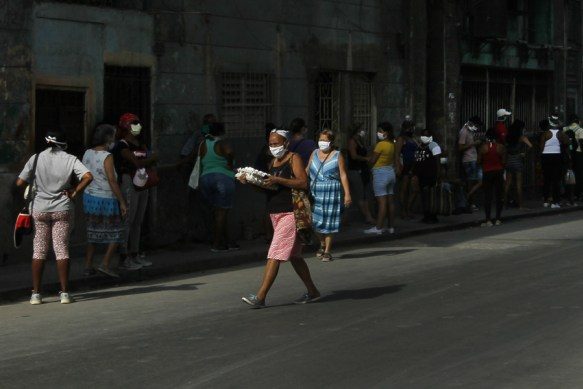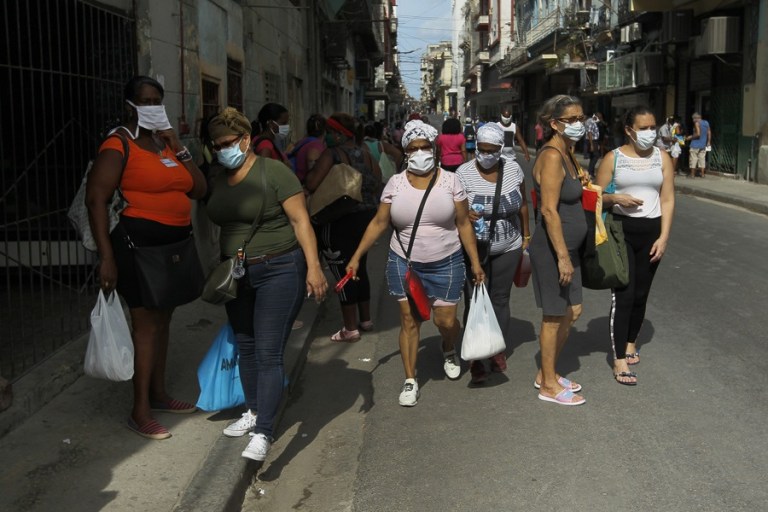Densely Populated Central Havana Is Extremely Vulnerable to Covid-19
Central Havana is one of the areas hit the hardest in the capital, as the number of positive COVID-19 cases has increased sharply in recent days.

HAVANA TIMES – Long lines of buyers have become a common sight in the Central Havana municipality, the most densely populated in all of Cuba, because of the COVID-19 outbreak on the Caribbean island.
Some of these crowds to buy chicken, soap, liquid detergent and other essentials, have gotten out of control and turned into mayhem.
The Cuban government is constantly calling upon its citizens to uphold social discipline, to respect social distancing guidelines, which mean standing a meter and a half away from each other in lines, and masks need to be worn.
However, in spite of the vast majority adhering to these regulations, there are still some people who ignore them and food isn’t being sold in neighborhoods, which contributes to the spreading of the virus. Cuba had reported 1,437 confirmed cases and 58 deaths by Monday April 27th.
Numbers of infection on the rise
The number of people infected, dying, in serious or critical condition, and recovered vary according to Ministry of Public Health’s daily briefing.
“My municipality, Central Havana, is one of the hardest hit, but it is also one of the most undisciplined. I see people without a mask or wearing it wrong, people sitting on the sidewalk, others visiting people, young people meeting up and walking down the street,” Aida Fuentes says, while she tries to keep her distance from others in the line.
Aida has been living in the Cayo Hueso (People’s Council of Cayo Hueso, according to its official name) neighborhood, in the Central Havana municipality, for 35 years now.
It is the smallest municipality, spanning just 3.42 km square km. It is made up by the Cayo Hueso, Dragones, Los Sitios, Colon and Pueblo Nuevo neighborhoods (People’s Councils), with a total of 99 divisions, one of which has special status.
With a population of 152,335 inhabitants living in the most densely populated municipality out of the 168 on the island, with 45,360.9 residents per square km. Often, up to three different generations live on top of each other in old apartments, as a result of the country’s chronic housing crisis.
The municipality has been in desperate need of a serious reconstruction for years now. This is particularly important when it comes to high-rise buildings, many of which don’t have an elevator.
According to experts, small private business owners have improved their homes (in spite of bureaucratic red-tape and how expensive building materials and labor are), although these renovations haven’t always been high quality in terms of construction or aesthetics.
Before the Coronavirus outbreak, the Cuban government had presented a Comprehensive Development Plan for the Central Havana municipality druing the revision of the capital’s Support Program, in February, which president Miguel Diaz-Canel and prime minister, Manuel Marrero, attended, as well as other State and Government officials.
According to the President’s website, Diaz-Canel had announced that the same principle that had guided social and renovation work in Old Havana, which had been carried out under the City Historian Eusebio Leal’s leadership, should be applied here.
This project is on standby for the moment.
The western province of Havana, one of 15 on the island, has 15 municipalities, nine of which are completely urban, and a total of 2.2 million inhabitants.
Cuba has been applying different degrees of social distancing and lockdown measures
Central Havana is one of the areas to be hit the hardest in the capital, and the number of confirmed COVID-19 cases has increased sharply in recent days. As a result, meetings have been held at the People’s Councils where the pandemic situation is being evaluated, and corresponding safety measures are being taken.
Since mid-April, quarantine measures were adopted on seven blocks at high risk (like some other parts of the capital) because of a concentration of confirmed cases, with an infection rate of 19.8 per 100,000 inhabitants.
The dilemma: stay at home or line up for chicken
However, residents in this area are facing the dilemma of staying at home – like the government is asking them to- or going out to look for food, especially chicken, because pork has pretty much disappeared and retail sellers want to sell it for an expensive price.
General panic to buy food has caused lines up to two blocks long, under a scorching sun.
“The lines are scary. There has to be a solution. There is a lot of exposure and I don’t think people keeping their distance in line is the solution,” 68-year-old Manuel Hernandez says, who belongs to one of the most vulnerable groups of catching COVID-19.

According to the minister of Domestic Trade, in the new phase of tackling COVID-19, retail points selling food, personal hygiene and hygiene items are being restructured so as to decentralize the service and, where access to stores limited, mobile retail points will be organized to bring products locally to neighborhoods.
The municipality at highest risk of COVID-19
On April 23rd, Central Havana became the highest-risk municipality in the capital, with an infection rate of 38.94 per 100,000 inhabitants, according to Havana’s Defense Council, which announced measures such as closing down retail points on busy Monte street.
However, reality has been different up until now. People continue to pile up in never-ending lines in front of stores so they can buy provisions, not afraid of becoming infected it seems.
In the face of this situation, the Pan American Health Organization’s delegation in Cuba recognized the good measures the government had taken, but also warned that they would need to organize food distribution so as to prevent COVID-19 from spreading.
Police keep order in lines
Police officers are stationed in many places, demanding that the public wear masks like them, making sure that people respect distancing as much as they can. They also ensure that panic and frustration doesn’t lead to physical outbursts like the ones that have taken place.
In Cayo Hueso’s emblematic Trillo park, there was an attempt to create chaos before the police patrol arrived, and people crowded around the La Habanera store.






I have never been to San Francisco but I have been to Havana. Any American or Canadian citizen living in a North American city, undoubtedly, finds the food supply and its availability in grocery stores pretty stable and reliable. Not so in Cuba.
Just for simple basics like soap, detergent, chicken, and other food stuffs, a Cuban needs to literally fight to obtain such provisions otherwise the shopper goes home empty handed. No doubt, not so in San Francisco.
Regarding social distancing, it is a well documented remedy from health professionals and integrated into all pandemic infected areas; however, its reliability and success is not universal as you alluded to because of crowds.
In Cuba, waiting under a hot sun for an innumerable amount of time, in an exhausting long line, for an item that the shopper, if lucky, can purchase is definitely intolerable and bordering inhumane. Such a sad situation is not tolerated in North American society yet the Cubans must continually endure this predicament whether in this present pandemic period or otherwise.
There is no comparable city to city comparison unless one evokes third world cities – densely populated African cities perhaps – and Havana in which case, yes, these citizens would be able to relate to Havana’s trials and tribulations.
There is research that does state hot, humid weather does hinder the proliferation of the virus. Hopefully, this is true in which case Havana which experiences some extremely, sometimes, unbearable summer temperatures will do well in that respect. Influenza, a related respiratory illness, spreads well in cool, dry conditions so if COVID-19 is from the same viral family, the summer weather should be advantageous towards Cubans living in Havana.
During the last few weeks, temperatures in Cuba have soared to 34 even 35C. But Covid 19 has continued to spread. For the first time (in my memory) shopping in Cuba has been properly described by Moses Patterson. He is correct, it is a form of scavenging:
“search for and collect anything usable”.
The incompetence of the retail outlets controlled by GAESA, has to be experienced to be believed. Dependent upon the US and in particular Tyson for frozen chicken, chaotic distribution, shelves of sauces but no pasta, electrical goods at mark-ups which any capitalist would love to be able to charge, long long line-ups when anything edible just happens to arrive – Es Cuba – following 60 long long years of the glorious revolution!.
COVID-19 is an international pandemic. My city, San Francisco, made some difficult and uncomfortable sacrifices early on in March to limit the spread of the virus and the death toll is relatively low as a result. San Francisco is very much like Havana in topography and population density but very different in terms of food security. Access to public transportation is also much better here. As a result, while San Franciscans live as close together as Cubans do in Havana, we are able to effect Social Distancing much easier. It is virtually impossible to avoid crowds in Havana when shopping( more like scavenging) for food or when waiting for and riding public transportation. The good news? It is still chilly at night and sometimes during the day here in San Francisco. It is believed that warmer weather reduces the virulousness of the virus and Havana is plenty warm.